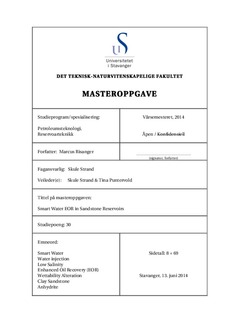| dc.contributor.author | Risanger, Marcus | |
| dc.date.accessioned | 2014-09-22T12:42:24Z | |
| dc.date.available | 2014-09-22T12:42:24Z | |
| dc.date.issued | 2014-06-13 | |
| dc.identifier.uri | http://hdl.handle.net/11250/220925 | |
| dc.description | Master's thesis in Petroleum engineering | nb_NO |
| dc.description.abstract | This study attempts to assess the viability of injecting medium-salinity brines of 25.000 ppm NaCl as a substitute for 1.000 ppm low-salinity Smart Water for injection in sandstone reservoirs, as well as study the effect of calcium precipitates in the formation on low-salinity Smart Water effects.
Yme-18 is flooded with 25.000 ppm NaCl after it was flooded to a production plateau using 100.000 ppm formation water—zero additional oil is produced. The 1.000 ppm NaCl flood that followed induced an increased production of 4 %. It was finally concluded that the 25.000 ppm brine was found ineffective in this particular system of rock/crude oil, most likely because of the relative concentrations of the different cations present.
Yme-19 was flooded with approximately 200 pore volumes of 1.000 ppm NaCl brine before the experiment in an attempt to remove anhydrite (CaSO4) from the core material. Yme-16 was flooded as little as possible, to compare results in an anhydrite rich and depleted core. While the attempt to clean out anhydrite from the core material failed, the concentration of sulfate in the critical low-salinity Smart Water interval was around 40 % lower.
Yme-19 and Yme-16 was flooded with formation water until plateau, then 1.000 ppm NaCl for an additional production of 2.5%OOIP and 2%OOIP, respectively. A discussion was carried out even though the additional recovery is most likely within experimental error, in light of very congruent results from the initial flooding of the two cores. The increased dissolution of sulfate and a higher initial pH was used as factors to explain the lower recovery from the Yme-16 core compared to Yme-19.
Indications of secondary wettability alteration towards a more oil-wet state by high-salinity reduction of capillary trapping was indicated in the Yme-19 and Yme-16 experiments. The proposed mechanisms and core response was discussed and the effect found plausible with the given data.
Suggestions for future work were derived from the experimental results and discussion. | nb_NO |
| dc.language.iso | eng | nb_NO |
| dc.publisher | University of Stavanger, Norway | nb_NO |
| dc.relation.ispartofseries | Masteroppgave/UIS-TN-IPT/2014; | |
| dc.rights | Attribution-NoDerivs 3.0 Norway | * |
| dc.rights.uri | http://creativecommons.org/licenses/by-nd/3.0/no/ | * |
| dc.subject | petroleumsteknologi | nb_NO |
| dc.subject | reservoir | nb_NO |
| dc.subject | smart water | nb_NO |
| dc.subject | low salinity | nb_NO |
| dc.subject | anhydrite | nb_NO |
| dc.subject | sandstone | nb_NO |
| dc.subject | wettability | nb_NO |
| dc.subject | eor | nb_NO |
| dc.subject | enhanced oil recovery | nb_NO |
| dc.title | Smart water EOR in sandstone reservoirs | nb_NO |
| dc.type | Master thesis | nb_NO |
| dc.subject.nsi | VDP::Technology: 500::Rock and petroleum disciplines: 510::Petroleum engineering: 512 | nb_NO |

